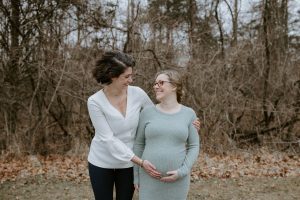The path to surrogacy is often one with more questions than answers.
In early January 2019, my husband, Seth, and I decided that it was time to start our own family. We met in graduate school in 2013 at the University of Maryland. Very shortly after meeting each other, Seth moved to Ann Arbor, and I moved to Montreal. It can be hard for two academics to find jobs in the same city. It took five years, 23 train rides, and 46 plane rides, but in 2018, we eventually both got jobs in Saint Louis. We were relieved and grateful for the opportunity to live in the same city, and the time seemed right to grow our family.

Fortunately for us, I got pregnant right away. A few weeks after I discovered I was pregnant, the nausea kicked in, and it kicked in hard. Soon, there wasn’t a minute of the day where I wasn’t thinking about how sick I felt. Things started to get even more serious during our 20-week anatomy scan. Our baby boy was measuring small, particularly his femur, which was smaller than all but 5% of other babies at his age. We came back five weeks later, and the news was worse. Luca, who we had named in the meantime, was measuring smaller than 1% of other babies his age and was then officially diagnosed as intrauterine growth restricted. We had to be admitted to the hospital immediately so that they could closely monitor Luca and me. That was June 26th; Luca was delivered on July 2nd and passed away in the NICU ten days later.
Why our pregnancy didn’t work out right remains a mystery. The only thing the doctors knew at the time is that I had pre-eclampsia. Pre-eclampsia is a pregnancy-specific condition— high blood pressure of pregnant women who had normal blood pressure before getting pregnant. It’s relatively common, affecting about 10% of pregnancies, but it usually arises much later in pregnancies and doesn’t usually affect the fetus. In September 2019, our high-risk doctor informed us that when (if) we try again, the pregnancy would be high risk, and I would most likely deliver another preterm baby, but this time, with the help of baby aspirin, we would hope and pray for 32 weeks. And if we got to 32 weeks, “we would throw a big party and pray for two more.”

That diagnosis led to our decision to use a gestational carrier. As soon as we made the decision, we quickly realized that there is not a lot of information about where to find gestational carriers, who uses them, and what the relationship between the gestational carrier and intended parents looks like. We don’t know anyone who has used one, so we were left on our own to make our decision.
After a few hiccups along the way, we settled on using American Surrogacy, and we have been matched with a really amazing carrier, Jennifer, right here in the Saint Louis area. We matched with her right when the pandemic started back in mid-February. Before meeting in person in late May, Jennifer and I texted every day and pretty much chatted about the same thing early couples do. ☺ She let me know which podcasts she’s was listening to, sent photos of her and her children, and asked me about my day. She is a nurse, so we sent her and her coworkers some personal protective equipment to use during the pandemic.
Since meeting in person in late May, we have really gotten close to Jennifer and her family. They welcomed us to a 4th of July BBQ (socially distanced, of course!), where she and her family had a chance to meet my mom and step-dad, as well. On her first day of the progesterone in oil protocol, which happened five days before embryo transfer, she, along with her boyfriend, Jake, and their three children, Facetimed with Seth and me so we could witness her first shot! I was her “plus 1” to embryo transfer at the fertility clinic (COVID regulations limit embryo transfer attendance), and today we are 13 weeks along! As I write this article, Jennifer just sent me a video of our baby’s heartbeat, which she recorded on her at-home Doppler.

Because I felt so alone during our gestational carrier search, I started a blog and Instagram account, @thebiggestask to share my own on-going journey, along with some interesting facts and experiences that anyone thinking about using a gestational carrier might consider. In 2013, about 2% of all embryo transfers involved a gestational carrier, and since then, we’ve seen an increase of about 0.5% a year. That means that if current trends continue, by 2030, at least 10% of all transfers will involve a gestational carrier!
Although our journey has been hard, I am grateful and excited to be at this point. I look forward to strengthening the bond with Jennifer and to living through an extremely unique experience.
Update:
On February 27th, 2021, we welcomed our baby boy Enzo via surrogacy. His early welcome to this world (he is a 34-week preemie) was once again due to pre-eclampsia, but he is currently doing very well in the NICU (fingers crossed). Jennifer, who has never once stopped amazing me throughout this journey, is discharged and doing well. We will be celebrating our one-year anniversary on March 5th ☺
 MaryJane Carnahan is an assistant professor of accounting at Washington University in Saint Louis. She and her husband just welcomed their second son, Enzo, via surrogacy. To provide more insight on all things surrogacy, she has started an Instagram account @thebiggestask to track her journey and to provide some information about surrogacy. She and her husband, Seth, are the proud parents of two kitties, Poutine and Mo.
MaryJane Carnahan is an assistant professor of accounting at Washington University in Saint Louis. She and her husband just welcomed their second son, Enzo, via surrogacy. To provide more insight on all things surrogacy, she has started an Instagram account @thebiggestask to track her journey and to provide some information about surrogacy. She and her husband, Seth, are the proud parents of two kitties, Poutine and Mo.










